Nestled in the heart of the Cascadian giant tree forests, the Olympic Peninsula is home to some of the largest and widest trees in the region. The interior of the Peninsula, which includes Olympic National Park and Olympic National Forest, is its most heavily forested area. Known for being one of the rainiest and cloudiest regions in North America, this area, along with Vancouver Island, is among Cascadia’s most biodiverse and productive forests.
The Peninsula hosts four major temperate rainforest valleys: the Hoh, Queets, Quinault, and Bogachiel. These valleys form a vast wilderness populated by towering western red cedar, Sitka spruce, Douglas fir, bigleaf maple, and western hemlock trees. Receiving nearly 12 feet of rain annually in certain areas, the consistent precipitation helps preserve the environment by preventing fires and promoting rapid tree growth.
This report covers the Olympic Peninsula and Washington Coast. For a guide to the ancient forests of the Washington Cascades.
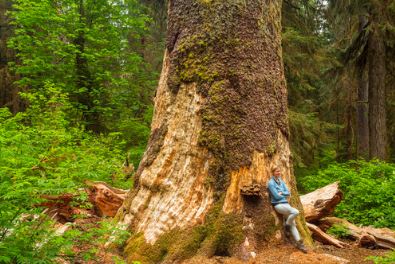
Preston Macy Sitka Spruce Tree
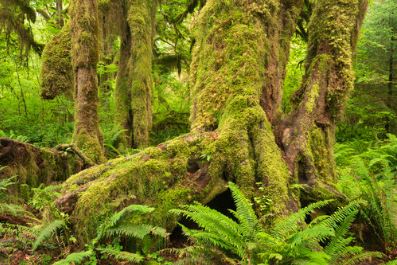
Hall of Mosses

Hall of Mosses

Spruce Nature Trail

Cedar Grove
Hoh River Trail
The Hoh River Trail is one of the most remarkable hikes in Olympic National Park and all of Cascadia. This 35-mile roundtrip trail winds through ancient groves of Sitka spruce, Douglas fir, and western red cedar alongside a glacially-fed river. Many of the old-growth trees along the trail are centuries old and reach immense sizes.
Heading toward the heart of the Olympic Mountains, the trail offers a unique feature: a trek into the mountains that culminates in a breathtaking view of the Blue Glacier near Mount Olympus. For those captivated by towering trees, the first 10 miles to Olympus Ranger Station/Lewis Meadows is the highlight. This campground makes an ideal spot for a relaxed overnight backpacking trip, providing a perfect turnaround point for those who want to enjoy the hike at a more leisurely pace.
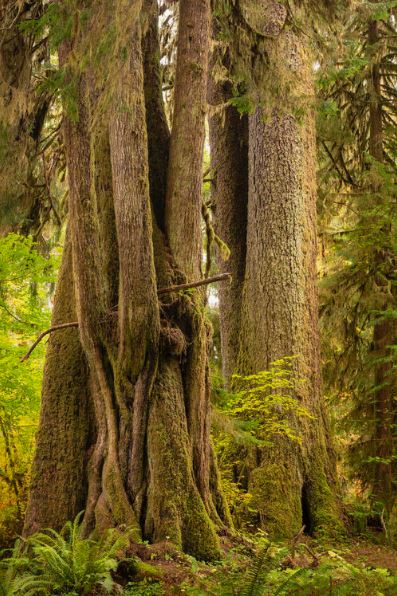
South Fork Hoh River Trail
The South Fork of the Hoh River originates from the Hubert Glacier on Mount Olympus’ southern flank, flowing westward into the main Hoh River near the Olympic National Park boundary. While the Hoh River Trail attracts many hikers and backpackers, the South Fork Hoh River Trail sees far fewer visitors, offering a peaceful retreat into a pristine old-growth rainforest.
Accessed via a series of logging roads, the South Fork Hoh campground and trailhead mark the transition between private and protected lands, highlighting the importance of preserving these forests. The trail starts in younger forest areas before entering Olympic National Park, where the landscape becomes more wild and dense. Here, ancient Bigleaf Maples, draped in moss, grow alongside clusters of towering Sitka spruces. The entire trail exudes a raw, untouched vibe, with campsites like Big Flat and Stick-in-Eye offering primitive, overgrown spots that deepen the sense of immersion in the South Fork Hoh wilderness. These campsites, with their rugged charm, emphasize the trail’s true wilderness experience.
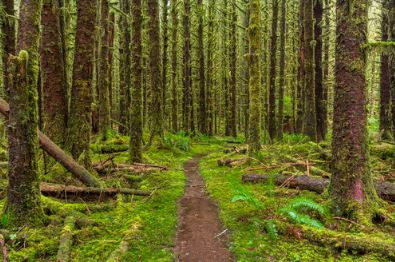
Quinault Rainforest
Quinault Rainforest: The Quinault Rainforest, one of Olympic National Park’s most accessible rainforests, is centered around Quinault Lake, where stunning old-growth forests line both shores, offering hiking opportunities for all skill levels.
The north end of the lake is less developed and sees fewer visitors than the south, especially after the fall of the Quinault Big Cedar. Though the trail to the fallen giant has been decommissioned, it remains a beautiful path surrounded by several towering trees.
Beyond the fallen cedar, the highlight of the north end is the Maple Glade Nature Trail. This short 0.5-mile trail winds through a dense grove of Bigleaf Maples, which are adorned with moss and thrive in a swampy environment. On calm days, the still water reflects the majestic trees, creating a tranquil and picturesque scene that makes this hike unique.

Quinault Big Cedar
Quinault National Recreation Trail System
The south end of Lake Quinault features several short rainforest hikes, all starting near Lake Quinault Lodge. Trails such as the Rain Forest Nature Trail, Gatton Creek Trail, and Falls Creek Trail lead through one of the finest Douglas fir forests in the Pacific Northwest. This area is home to some of Olympic National Park’s tallest and largest Douglas firs, including Tichipawa, Gatton Goliath, Quamal, and Rex—legendary trees that are iconic in the region.
Among the best stands of Douglas fir are found along the Gatton Creek and Rain Forest Nature Trails, where the trees reach their full height and girth. Enthusiasts of giant trees have dubbed a section of this rainforest the “Miracle Acre,” a dense grove of 400-year-old trees that holds the regional record for wood weight per acre. This breathtaking forest is a testament to the impressive scale and majesty of Olympic’s old-growth trees.

enchanted valley
The Enchanted Valley hike, on par with other major multi-day rainforest trails in Olympic National Park like the Hoh and Queets River trails, lives up to its name. Over 12 miles (one way), hikers follow the Quinault River, passing towering trees such as cedars, firs, spruces, and hemlocks—an impressive display of ancient, old-growth forest shaped by the Olympic Peninsula’s unique climate. The areas around the O’Neill Creek and Pyrites Creek campsites feature particularly stunning groves and ancient trees.
The trail culminates at the Enchanted Valley, also known as the Valley of 10,000 Waterfalls, where steep mountains encircle a lush meadow. This picturesque spot is home to the historic but closed Enchanted Valley Chalet, along with black bears and Roosevelt elk. For stunning views of the valley, be sure to check out the Olympic Mountains section of this guide.

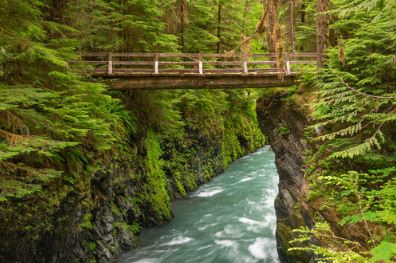
Big creek trail
The Big Creek Trail, located past the east end of Lake Quinault, is an often-overlooked gem, home to the largest Alaska yellow cedar. But its beauty goes beyond that. The trail features a remarkable collection of massive cedars and Douglas firs. The second and third miles from the trailhead showcase towering trees, some fused and others single-stemmed. After crossing Big Creek, the trail climbs through a grove of impressive Alaska yellow cedars, culminating at the largest specimen in the group, making it a must-see for tree enthusiasts.

North Fork Quinault Trail
Located between the Enchanted Valley and Big Creek Trail, the North Fork of the Quinault River trail offers a classic low-elevation forest experience for its first 10 miles. While the old-growth here isn’t as awe-inspiring as those on nearby trails, the first five miles still offer a beautiful hike. Beyond this section, stream crossings can become difficult, especially after heavy rain or during spring melt.
A standout feature of this section occurs about 1.7 miles from the trailhead, halfway to Wolf Bar Camp. Here, the forest opens into a flat area, where large western red cedars and bigleaf maples line the trail. This scenic landscape makes for great photo opportunities, and I discovered a grove off-trail in this area that provided some of my favorite shots from the hike.


Campbell Tree Grove
I’d be remiss not to mention the best campground in the region, though it’s in an adjacent valley. The Campbell Tree Grove Campground, situated along the West Fork Humptulips River, is a secluded spot far from civilization. Surrounded by towering ancient Douglas firs and weathered western red cedars, it’s worth the detour for a peaceful night under the canopy of giant trees.
Queets Rainforest
Queets River Trail: Due to its relative inaccessibility, the Queets receives far fewer visitors than the Hoh, preserving its wilderness charm. The rainforest is home to some massive trees, including the moss-covered Queets Spruce, one of the largest Sitka spruces in the world, and the Queets Fir, the thickest known Douglas fir. The Queets River Trail begins with a ford of the river, typically safe only in late summer. As the trail ventures deeper into Olympic National Park, it passes towering trees draped in lush ferns and moss, creating a truly magnificent, untouched landscape.

Sam’s River Loop Trail
While it lacks the towering trees found across the river on the Queets River Trail, the Sam’s River Loop Trail offers a unique charm of its own. This 2.5-mile loop circles the Queets Campground and ranger station, passing through a forest filled with moss-draped trees. The trail is lined with impressive bigleaf maples and western hemlocks, their branches covered in lush flora. Unlike many of the park’s major river valley hikes, this trail feels spacious and open, crossing fields of vibrant grass. There are two spots where the path fades, and hikers must follow signs across the grassy wetlands to continue. Though short, it’s a fantastic and accessible introduction to the rainforest, ideal for those who prefer not to ford the river into deeper parts of the Queets.
Bogachiel Rainforest
Ira Spring Wetland Loop:
The Ira Spring Wetland Loop, encircling a dense stand of old-growth Sitka spruces on a flat watershed, offers a fantastic introduction to the Peninsula’s ancient forests. Located entirely within Olympic National Forest, the trail reaches the National Park boundary.
The northern section of the loop rises above the watershed, passing through a mix of diverse flora. However, it’s the southern end, closer to the Bogachiel River, that showcases the park’s largest trees. These giants thrive in the perpetually saturated rainforest environment.
This short loop makes a perfect day-trip alternative to the more demanding Bogachiel River Trail, a multi-day backpacking trek deeper into the park.
Bogachiel Rainforest River trail
The Bogachiel, the northernmost and least visited of Olympic National Park’s four rainforest valleys, is a stunning example of old-growth beauty. The Bogachiel Rainforest River Trail, the valley’s sole trail, begins east of the Ira Springs Wetlands Loop and stretches nearly 30 miles to Sol Duc Hot Springs Road. It also marks the western end of the 1,200-mile Pacific Northwest National Scenic Trail, which spans three states near the Canadian border.
Rugged Ridge (Indian Pass) Trail
The Rugged Ridge/Indian Pass Trail, a lesser-known offshoot of the Bogachiel River Trail, holds special appeal for big tree enthusiasts due to a grove of massive, ancient Douglas firs. Located off-trail about two miles north of the main trail, the trees rest on a small knoll, accessible only to experienced hikers. The largest, the “Indian Pass Tree,” measures nearly 12 feet in diameter—a true wall of wood and an impressive sight for tree lovers.
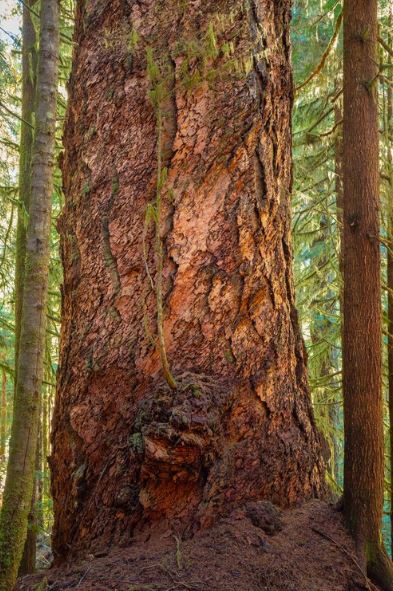
Indian Pass Tree
Kalaloch Big Cedar
The abundant rain and constant mist from the nearby Pacific Ocean allow several western red cedars in the park’s western end to reach record sizes. One iconic example of this is the Kalaloch Big Cedar, a tree that stands out as one of the gnarliest in the region. Its base is covered with interlocking arms of wood that extend from the roots up the trunk. Before a violent storm in 2014 split it in half, the Kalaloch was already an unusual tree. Despite this, it still stands, showcasing the incredible strength and resilience of these ancient giants.
The Duncan Cedar & Grove
The Duncan Cedar, also known as the Nolan Creek Cedar, is a more traditional-looking western red cedar compared to the Kalaloch Big Cedar. This coastal giant stands amidst land once clearcut long ago, leaving it exposed to the sun for years. The exposure has bleached its massive trunk to an off-white color, making it stand out against the surrounding newer, green forest. Following the fall of the Quinault Big Cedar, the Duncan Cedar became Washington’s largest cedar.
On the drive to the Duncan Cedar, a small patch of old-growth forest is preserved among second-growth land. Located about two miles from Highway 101, it’s marked only by a tree drawing pointing to a boardwalk trail. Few visitors know of it, maintaining its wild atmosphere. The short trail leads to a few giant trees, some reaching 8-9 feet in diameter at breast height.
Lake Crescent
Nestled in the northern part of the Olympic Peninsula, beautiful Lake Crescent is surrounded by old-growth forests dominated by Douglas fir and bigleaf maple. Highway 101 (Olympic Highway) runs along the lake’s southern edge, offering stunning views of the lake and its surrounding hills. At the western end of the lake, Camp David Jr. Road branches off, leading through spectacular groves and ending at a boat launch surrounded by impressive trees.
The giant bigleaf maple pictured here stands alone in a clearing, exposed to the elements. Its massive branches are covered in moss, typical of bigleaf maples, highlighting how these trees serve as hosts to various plants, ferns, lichen, and other organisms.
Along the short trail to Marymere Falls, more enormous trees can be found, including half a dozen massive cedars and a few towering Douglas firs, such as the one shown here.
Shady Lane Trail & Staircase Rapids Loop
In the southeastern part of Olympic National Park, where the North Fork Skokomish River meets Lake Cushman, hikers can explore a mix of old-growth forests, waterfalls, and river rapids. Starting at the Staircase Ranger Station, the Shady Lane Trail follows the river along its southern end, passing through some large, unique trees. For those seeking giant trees, this trail is the standout in the region. Though only two miles long and somewhat overgrown in sections, the trees are ancient, and the forest is ecologically diverse.
North of the ranger station, the Staircase Rapids Loop follows the North Fork Skokomish along both its east and west banks. While the trail features some large trees, they don’t compare to the giants on Shady Lane. Instead, the main draw here is the river, with stunning views of it cascading through multiple waterfalls.
Nearby, the Beaver Pond Trail offers one of the best groves of moss-covered bigleaf maples. The pond, as the name suggests, is a habitat for beavers and various bird species. The maples on the western half of the loop are particularly remarkable, with towering, staggering sizes that showcase the grandeur of the forest.
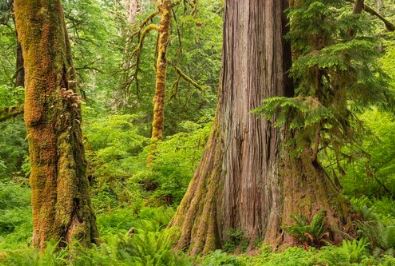
Spruce burl trail
One of the most unusual groves on the Olympic Peninsula can be found on a side path to Beach 1, where the spruces are leafless, windswept, and covered in massive burls along their trunks. These mysterious growths, though curious, are believed to be harmless. The burls are strikingly large compared to the small, slender trees they grow on. The loop trail is just a short distance, but spruce burls can be spotted all along the coast, especially farther north, providing an easy off-trail adventure for those seeking more exploration.
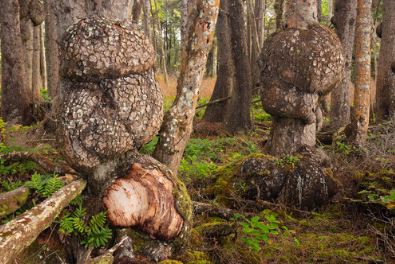
Ancient Groves Nature Trail
On the way to the Sol Duc Falls trailhead, travelers can explore the 0.4-mile Ancient Groves Nature Trail, which weaves through a lush, mossy forest. While the trees aren’t exceptionally large, the setting is stunning. The area is best visited in winter or early spring when the forest floor is vibrant with greenery and swampy, photogenic pools form between the trees.
Long Island/DOn Bonker Cedar Grove
Located in the southwest corner of Washington State, Long Island holds the highest concentration of giant western red cedars in western Washington, outside Olympic National Park. As part of the Willapa National Wildlife Refuge, the island remains roadless, helping to preserve its impressive collection of old-growth trees.

The cedars are located in the 274-acre Don Bonker Cedar Grove, in the island’s central area. These ancient giants, standing for nearly 1,000 years, rise like titans amidst dense vegetation. A short loop trail leads hikers through a small section of the grove, showcasing trees in various stages of growth and decay. Some of the oldest specimens bear witness to ancient fires.
The largest and most impressive trees aren’t near the official trail but are found about 1/4 mile south, clinging to a hillside. The massive cedars pictured in photos three and five grow here and are among the largest in the area. Reaching them is challenging, requiring intense bushwhacking.
Source: LUCAS COMETTO Wilderness Photography https://www.lucascometto.com/cascadia-olympic-peninsula


